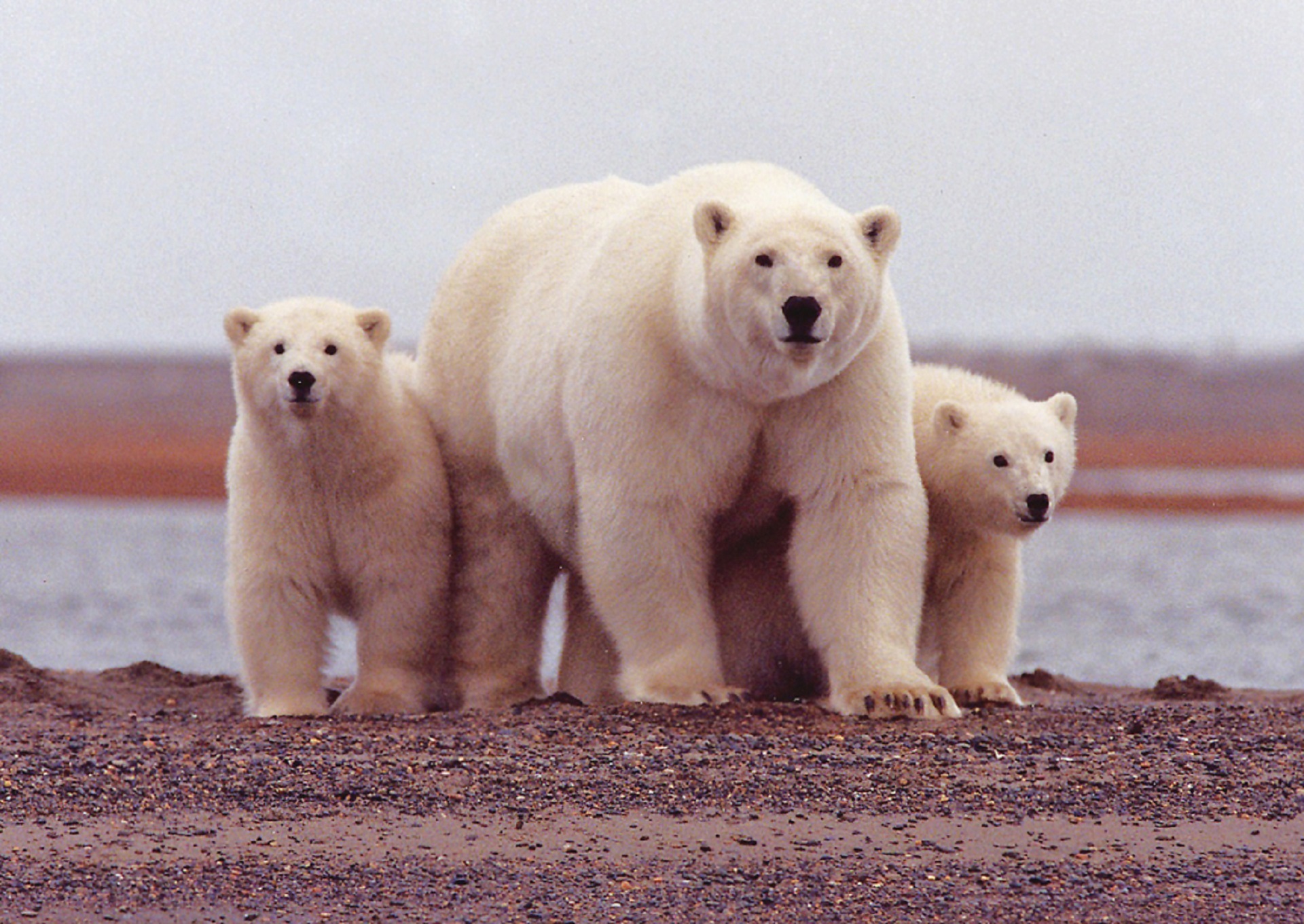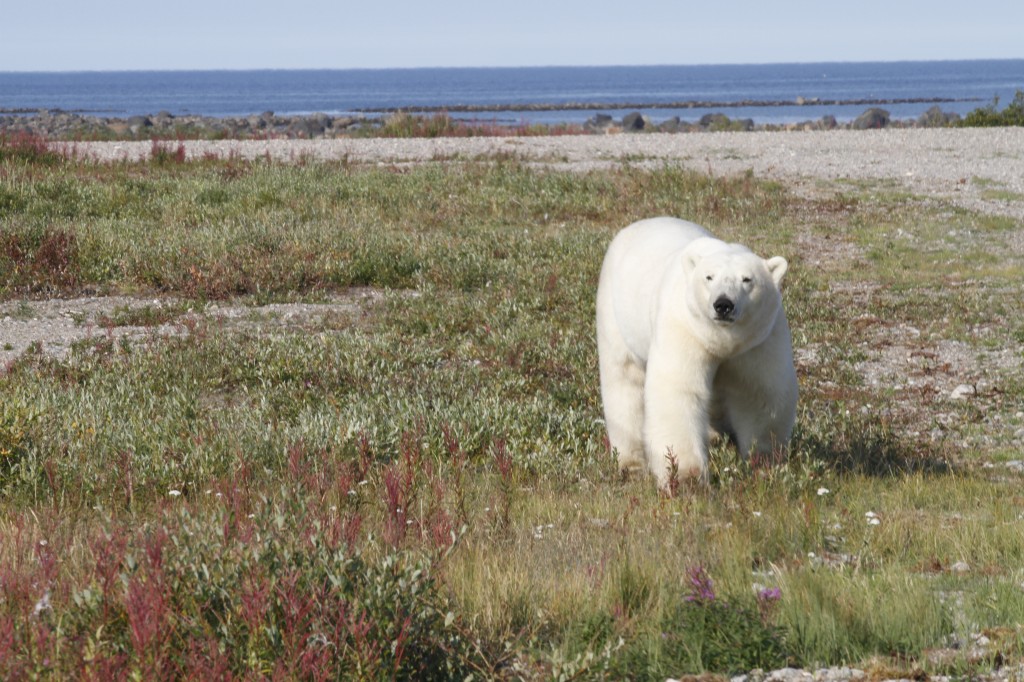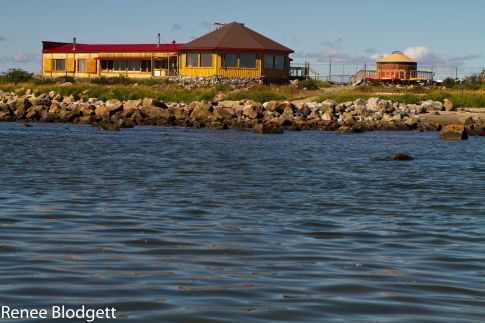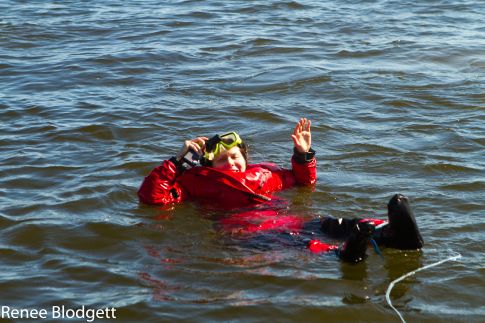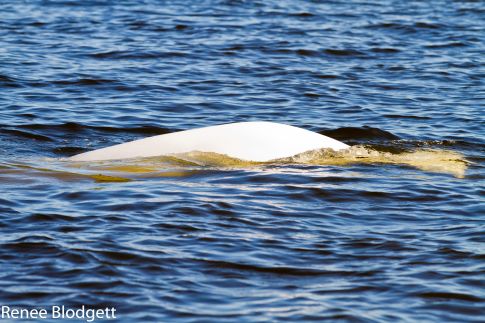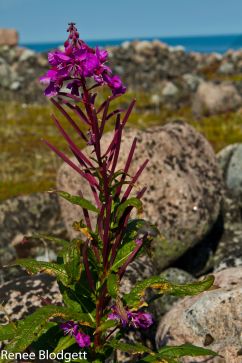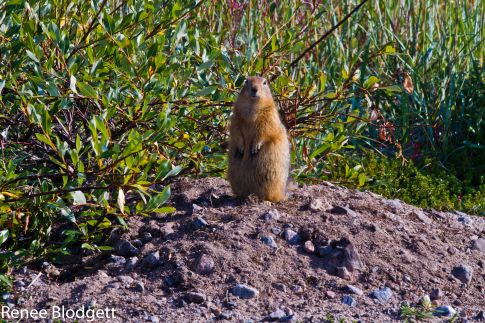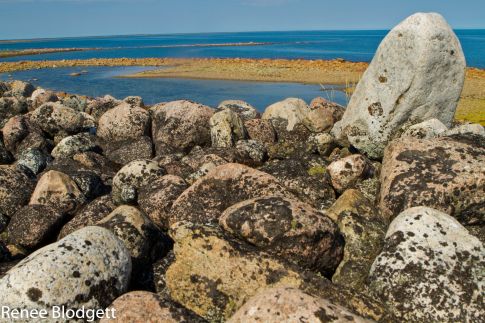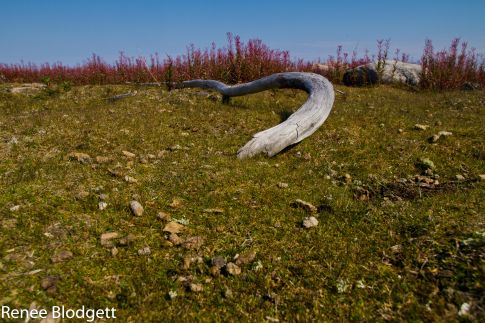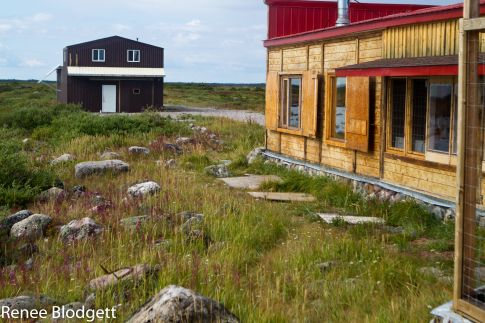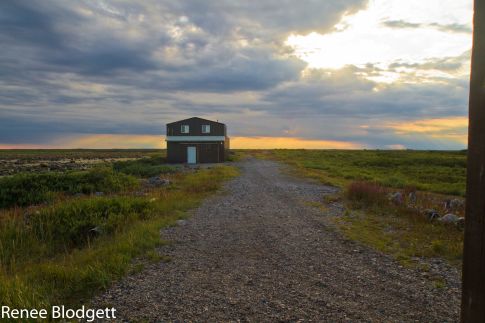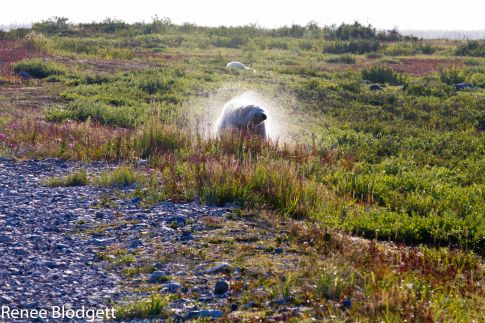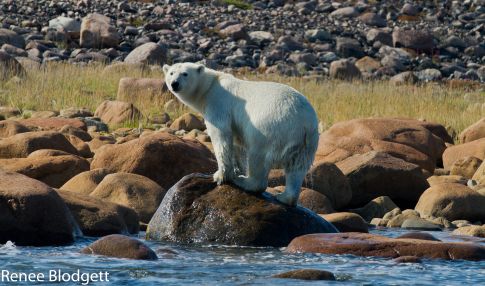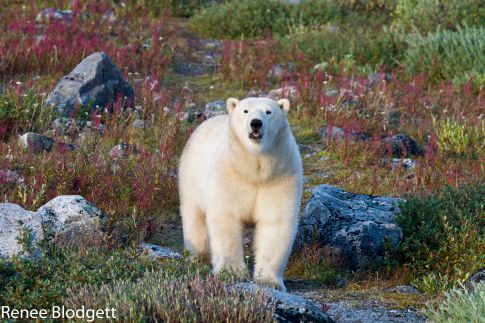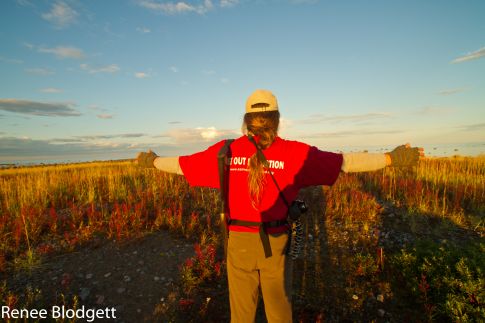The lodge was primarily why I had come. It wasn’t any lodge and it wasn’t really ‘about’ the lodge, but its location, surrounded by thorny sharp rocks and nestled up against the Canadian Arctic Hudson Bay in Northern Manitoba. One doesn’t jump on four airplanes, one of them being a bush plane, to travel to a colder climate without more than a passing thought, unless of course you’re enticed by these 5 tantalizing words: Polar Bears in the Wild.
Churchill Wild and Manitoba Tourism had reached out to me more than six months ago to invite me on this breathtakingly beautiful experience and despite the fact that I travel a lot and have taken in 5 of the 7 natural wonders of the world and 5 of the 7 ancient wonders of the world, I was enthralled with the idea of seeing polar bears in the wild. They have four lodges in different areas: Dymond Lake Eco Lodge, Nanuk Polar Bear Lodge (just opened), North Knife Lake Wilderness Lodge and the one I stayed at, Seal River Heritage Lodge.
The lodges are remote, remote enough that you have to fly in over the Hudson Bay from the town of Churchill since there are no roads leading into the area.
Seal River’s lodge is located roughly 50 km from Churchill, it was strategically built on Hudson Bay’s shores, near the Seal River estuary.
What do you do if you’re a polar bear in the summer when the snow and ice have melted? You come ashore of course to conserve your energy until winter returns when you can head back onto the ice and hunt seals again.
The properties, which are owned and run by husband and wife team Mike and Jeanne Reimer, have grown in popularity among nature addicts and those seeking unusual adventure travel experiences. For someone who has done her fair share of exotic adventure experiences, this one gets 5 stars.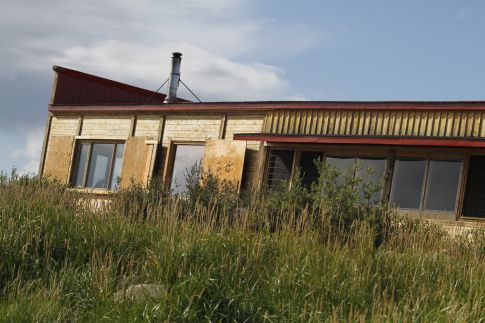
For example, I have ridden on elephants as they’ve charged through tall lemon-colored grass looking for tigers in southern Nepal and in northern Thailand, gone on a dozen or so safaris in East and Southern Africa, ridden a camel from Jerusalem to a remote Beduoin desert and another one some 10 miles from the Saudi Arabian border.
I have swung through trees in the South American Amazon, driven the gun run from Malawi through Mozambique, seen Komodo Dragons in Indonesia, taken a ship out onto Alaska’s ice glaciers and mambo-ed up a storm in Guatemala.
I’ve had lunch with a Prince in India’s Rajasthan, crossed the Somalian border by foot, went diving in Australia’s Great Barrier Reef, watched gorillas in the Rwanda and Ugandan forests before they opened it up to tourists, ridden an ostrich in Africa and swam with turtles in the Galapagos Islands. And alas, at Churchill Wild, gazed into a polar bear’s eyes through tall grass and was mesmorized by his beauty and fun spirit.
Even though I still get a thrill by visting any new place for the first time as I wrote about recently on my way to Calgary, the bar gets higher the more you’ve traveled. As for top adventure experiences in the world, Churchill Wild ranks up there as one of the top places you should visit in your lifetime, particularly if you love nature and being out in the wild.
There’s something awe-inspiring and breathtaking about seeing polar bears in the wild and watching them in their natural habitat – play, eat, flirt, roll on their backs and yes, even sleep.
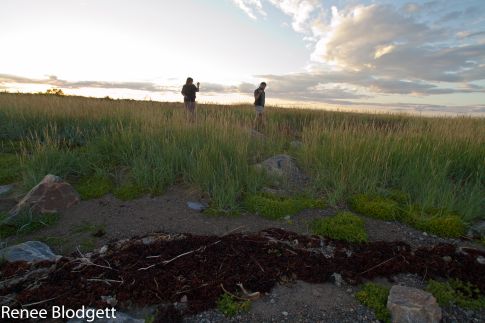 What makes Churchill Wild so unique is that you are surrounded by a combination of raw beauty and polar bears on every side of you amidst a cool Arctic sky.
What makes Churchill Wild so unique is that you are surrounded by a combination of raw beauty and polar bears on every side of you amidst a cool Arctic sky.
Like sleeping in the African wild, you cannot go for a leisurely stroll outside the lodge since you may just run into a polar bear when you least expect it.
There are roughly 950 of these polar bears along Western Hudson Bay shores and roughly 25,000 Beluga whales in nearby waters.
Depending on the time of year you head north, you can kayak or swim with the belugas while viewing their adorable dolphin-like faces through a mask.
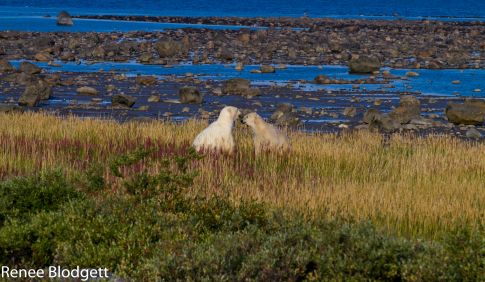
I jumped off the side of a boat with a dry suit on and did precisely that – the experience was truly incredible.
If you head north, be sure to include extra time to hang out with the beluga whales as well — it’s magical to listen to them underwater…a bit like a flock of birds and fish all singing together in unison at the same time.
If you’re into native birds, be sure to bring your binoculars since you’re likely to spot some while you’re trekking along the Hudson Bay.
If you’re interested in heading north in the summer or fall to hang out with the polar bears and beluga whales, here’s how it works:
- Fly to Winnipeg. You need to go through Winnipeg to get to Churchill, so spend a day and an evening there, taking in Winnipeg’s art galleries and cultural activities. Go down to the Forks area to see the construction of Canadian Museum of Human Rights, which is slated to open in 2013. Have dinner in one of their fabulous restaurants. (see my Winnipeg write-ups on 3 different restaurants: Deseo, Peasant Cookery and ELEMENTS).
- Fly to Churchill on the afternoon before you’re due to catch the bush plane over the Hudson to the Lodge. Churchill is a quirky town full of fascinating characters who have a ton of odd and funny stories to tell. Visit the Eskimo Museum, have dinner at the Lazy Bear Lodge and go for a drive to Cape Mary and along the Back Road. (it’s what the locals call it). See my Churchill write-ups here and here.
- Fly to the Lodge: once you land at the lodge, Mike and Jeannie’s team go into motion. One of the guides will greet you at the edge of the dock in a contraption that looks a bit like a quad except that it can seat up to 12 people including luggage. It is possible that you’ll see a polar bear on the short ten minute ride up to the lodge, so brace yourself just in case.
Day 1: likely the first day will be spent with a late afternoon walk with your guide after a short snack and tea when you land.
You’ll have time to get settled in your rooms and browse through one of the many stunning photo coffee table books that are loaded with shots of polar bears against snow and ice as well as luscious pink fire weed.
Dinner will be served in the large dining room when you return, which has an open kitchen, so you can see the girls preparing your salads, soups and homemade fresh bread.
Logistical note: the dining room is where the wifi is the strongest although you can get access in the main lounge area as well, but the signal is not as strong.
Dining Room area above – overlooks the Hudson Bay and below, lounge area to the left and bedroom to the right. Many of the rooms also have bunk beds, which is ideal for families. The lounge area and the dining room both have fabulous views of the bay and you can often spot polar bears from inside, both in the mornings and afternoons.
Day 2: you’ll likely do a couple of hikes on the second day and depending on how long your trip is, you’ll either hike entirely by foot or alternate them with trips out in the buggy.
Above: Amanda Dunning of Kensington Tours, Renee Blodgett/We Blog the World, Tom Stanley of Cox & Kings
Days 3-5: the schedule will depend on weather conditions, the group and what experience the guide(s) think will be best given the time of year, activity patterns and so on. As I mentioned above, one option is to go swimming with the beluga whales in a dry suit (they provide them). With a dry suit on and if you dress warmly (turtleneck, fleece, long underwear), you should be fine for the short duration you’re in the water.
You tend to be so excited about the whales buzzing around you that you forget about the cold during the experience. There could be as many as a dozen whales buzzing around you at any given time and even if you don’t see them clearly underwater, you will definitely hear them.
And, from above the surface, you’ll see them in pairs circling the boat, circling you, jumping and whizzing by as their graceful humps appear on the surface before they go below again. From the town of Churchill, you can also go kayacking with the belugas as well which is worth doing if you have the time.
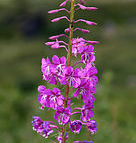
You’ll take in more hiking, as well as viewing from the lodge itself — from the deck, the look out tower and from inside the dining room, which is plastered in large ceiling to floor windows.
If the wind is light, they may take a trip out to Fireweed Island, which is loaded with stunningly beautiful fireweed in the summer. See my photo blog post on Fireweed Island.
An herb which is mostly abundant in wet calcareous to slightly acidic soils in open fields, pastures, and particularly burned-over lands, the name Fireweed derives from the species’ abundance as a coloniser on burnt sites after forest fires. Its color – bright fuschia pink in full bloom, a slightly more subdued pink when the season is trailing off, is electric and alive.
Seeing a vast field of vivacious fireweed is a truly amazing experience and one to treasure, particularly if you’re lucky enough to have clear blue skies and a warm sunshine beating on your face at the same time.
Other animals in the area include arctic terns, caribou, foxes, gulls, spruce grouse, little gulls, and arctic ground squirrels also known as the richardsons ground squirrel. The Innu call the ground squirrels sik sik and we saw a number of them out on our hikes.
Vegetation and flowers include jewel lichen (which we saw on the island rocks during our day trip), larch, spruce, cloudberry, snow willow, blueberries, bearberries, tall cotton-grass (everywhere), marsh willowherb, seabeach sandwort, alpine azalea, yarrow, bog rosemary and more.
THINGS YOU NEED TO KNOW:
Food: the meals are freshly made each day. Breakfast include yogurt, fruit and granola each day and they alternate bacon and eggs with toast and pastries although you can ask them to accommodate specific dietary needs if you have any. Lunches are homemade soups and salads with homemade bread and dinners included a meat, sometimes a potato, vegetables and salads. On the last night, we had a very tender caribou steak medium rare that was to die for. It was served with cauliflower, salad and potatoes. They also serve dessert every night – baked bars, cakes, ice cream and pies.
Internet: the Lodge is most definitely off-the-beaten track and a main reason why you’re going to a remote area to hang out with polar bears. That said, as a writer, “I get” the need to be online, whether its sending emails to your kids or running your business from the road. They have wireless in the lodge as noted above under Day 1, in two main areas, but not the rooms. They use satellite so ask that you don’t upload or download any large files as it can get pretty expensive.
The Rooms: the rooms are fairly basic, so prepare for those expectations before you leave home…you’re not heading to a luxurious accommodation but they are clean and the staff tidies up every day. For couples, you can get a double bed, most of which have a bunk bed in the room as they tend to see more families passing through than not. Remember that you’re not going for luxury, you’re going for nature, rustic and the Arctic experience.
There are no views from the rooms at this time and there was no heat when I was there in August — they do turn the heat on in the Fall when it gets chillier. I get incredibly cold and was fine without heat but did ask for a couple extra blankets just in case. My room had two single beds with an unstained wooden shelfing unit for clothes. Note that I was comfy and slept soundly every night. Each room has its own bathroom with a shower however and the water pressure is great.
Additional note: the rooms have bars on the windows because the bears have been known to paw through the glass. There was something slightly exciting about that for me, knowing that I might hear a scratch or two when I least expected it. The lodge is extremely safe and well fenced in, but if you are particularly squeemish, ask for a room on the ‘compound’ side of the lodge, which has an extra barrier between you and the tundra. Personally, I wanted to open my curtains and see a bear clamoring up the window to peer in.
What to Bring:
- Windbreaker Jacket with a lining (gortex if you have it)
- Wellies – if you’re English, you know what these are and if you’re not, think rubber boots that come up to your calves or knees. They go over your jeans or rain pants.
- Rain pants (very useful in these conditions) regardless of the time of year.
- A flashlight (always useful).
- A bug jacket – okay, if you don’t know what one is, or have a clue where to buy one, they do have some at the lodge and you can also purchase them at the hardware store immediately across from Churchill’s Seaport Hotel in the center of town before you plane it up to the lodge.
- A fleece or two.
- Durable hiking boots.
- Warm Socks.
- Sweatshirt and a sweater.
- A turtleneck to wear underneath the dry suit.
- Clothes/T-shirts for layering in case the sun comes out and it’s too warm for your heavier clothing.
- Thermals/long underwear. This is useful for underneath a pair of rain pants and your dry suit when you’re in the water.
- Hat/Gloves – useful for the boat ride to the neighboring islands and when you go to see the Beluga whales.
- Bug Repellant.
- A day pack.
- Camera and gear.
- Binoculars.
- A Notebook for jotting down useful stuff about the plants, vegetation, and anything else you learn along the way.
Bugs: Note to the light hearted. There are BUGS! You’ll be in Canada in the summer along the Hudson Bay – it’s buggy, moreso than Minnesota and the Dakotas, moreso than New Hampshire and Maine, moreso anything you’ve probably experienced. That said, when I was there in late August, there were barely any to deal with, so it does depend on the amount of rain, the temperature and time of year. If there are a lot of bugs, there are things you can do to be prepared. When the bugs are swarming, you definitely want a bug jacket, which covers your upper body and head in its entirety. The hardware store across from The Seaside Hotel in the town of Churchill carry them if you don’t want to get one in advance. I had fun modeling for the locals.
Remember the other things that bugs hate: garlic and tonic water. Drink garlic tea, eat cloves of it, take the tabs and drink tonic water. And, of course, if you’re not adverse to chemicals, bring the ole deet and bug sprays and cover yourself before you head out. Everyone who has gone in the bush, the forests, the tundra and beyond know, the best animal viewing is early morning and late afternoon when the bugs tend to be the worst. Prepare for it and you’ll be fine. Besides, how often do you get to wear a bug jacket.
OR see end-of-day views from the lodge.
Bears: If a bear approaches you and for some very unlikely reason, your guide isn’t around with his gun, don’t make any sudden jerks or movements. Slow down, back up and move deliberately. We had a couple come up to the large-holed wire fence when we were there, so I was about five feet away at one juncture.
It was a “her” and she wasn’t amused that we were observing like papparazzi while she was flirting with her new ‘boy bear’ friend who approached her in the field. I looked her straight in the eye at one point and it didn’t seem to phase her, anger her, excite her or any of the above. Use common sense if there’s a cub in the picture. If you’re a mother, you’d do anything to protect your child, wouldn’t you?
The other thing to know about the polar bears is that they’re one of the most beautiful, amusing and interesting creatures you’ll come across. Bear in mind when that this isn’t always true if you encounter a lazy one who doesn’t move for 48 hours at a time, but this is less likely to be the case during Churchill Wild’s peak seasons. Our guide – Terry – was extremely cautious about letting us get too close when we were out hiking around them.
If you’re a nature and adventure lover, the Churchill Wild experience is a must do. How often do you get an opportunity to hang out safely with polar bears in the wild, in a protected environment, where the birds are cooing in the background and you’re surrounded by vibrant and colorful pink fireweed in the foreground?
Churchill Wild is unique in that it offers an experience that no other part of the world does and your hosts are pure Canadian in everything that means: friendly, down-to-earth, great cooks, family-oriented, nature lovers and they support sustainable practices.
Below is a video I shot of owners Jeanne and Mike on how they got started and their inspiration behind Churchill Wild. Their energy is so warm and inviting that you’ll want to fly up to Churchill just to hang out with them for a few days…
Photo credits: Dining room shot: Charles Glatzer. Main Lounge area: Seal River site. All other photos: Renee Blodgett.

Renee Blodgett is the founder of We Blog the World. The site combines the magic of an online culture and travel magazine with a global blog network and has contributors from every continent in the world. Having lived in 10 countries and explored nearly 80, she is an avid traveler, and a lover, observer and participant in cultural diversity.
She is also the CEO and founder of Magic Sauce Media, a new media services consultancy focused on viral marketing, social media, branding, events and PR. For over 20 years, she has helped companies from 12 countries get traction in the market. Known for her global and organic approach to product and corporate launches, Renee practices what she pitches and as an active user of social media, she helps clients navigate digital waters from around the world. Renee has been blogging for over 16 years and regularly writes on her personal blog Down the Avenue, Huffington Post, BlogHer, We Blog the World and other sites. She was ranked #12 Social Media Influencer by Forbes Magazine and is listed as a new media influencer and game changer on various sites and books on the new media revolution. In 2013, she was listed as the 6th most influential woman in social media by Forbes Magazine on a Top 20 List.
Her passion for art, storytelling and photography led to the launch of Magic Sauce Photography, which is a visual extension of her writing, the result of which has led to producing six photo books: Galapagos Islands, London, South Africa, Rome, Urbanization and Ecuador.
Renee is also the co-founder of Traveling Geeks, an initiative that brings entrepreneurs, thought leaders, bloggers, creators, curators and influencers to other countries to share and learn from peers, governments, corporations, and the general public in order to educate, share, evaluate, and promote innovative technologies.

